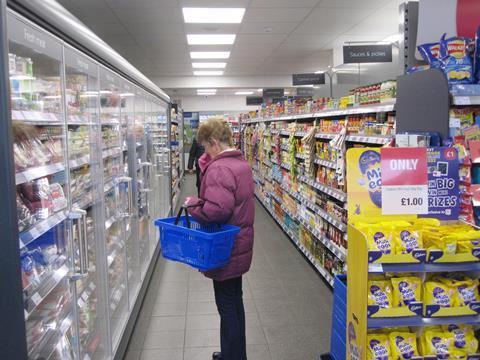A modern convenience range can lead to a heavy cost in energy bills, but Scotmid Co-operative has some award-winning ideas for savings.

Soft drinks, milk, alcohol and fresh foods are increasingly becoming the mainstays of a modern convenience store offer. What links them, apart from the essential part they play in the sales mix, is that they all have to be refrigerated to some degree or other to maximise their appeal to the consumer. As a result, the amount of refrigerated space in use across the convenience store industry has grown, and continues to grow.
But there’s the problem. As the quantity of installed refrigeration increases so, potentially, does the energy bill. Add to that increasing customer demand for hot food and other food-to-go options requiring specialist equipment, plus an increasing requirement for feature lighting to show products off to their most attractive extent, and energy efficiency has become an increasingly urgent imperative for store owners and operators.
As a retail group, Scotmid saw that its energy bills were potentially a big drain on profitability, so embarked on a company-wide project to cut energy usage without affecting the customer experience or product range adversely. The progress the group has made was acknowledged with the Energy Efficiency Award at this year’s Convenience Retail Awards.
To kick off, the company held a conference to which suppliers, contractors, energy consultants and the power companies were all invited, to identify how energy usage could be reduced across the business. The suggestions were pooled and then implemented in stores across the business.
For a typical modern c-store, more than half of the energy use comes from refrigeration, so this is the obvious place to start looking for the biggest savings.
Stores recently refitted by Scotmid, such the Bankton convenience store in Prestonpans, East Lothian, have doors on chiller cabinets as standard. The store has also benefitted from the latest energy-efficient cabinets using the latest CO2 gas refrigerant, controlled through a centralised Energy Management System (EMS). In the first six months following the refit, energy consumption at Bankton fell by more than 62,000 kWh, and this is despite additional chilled and freezer space being added as part of the store revamp.
A joined-up, systematic approach to refrigeration can help save energy elsewhere, too. For example, the warm water by-product of the refrigeration pack in use at Prestonpans is used to heat the store, and energy efficiency is further enhanced by EndoTherm, an organic additive to the water-based system which improves the thermal properties of water. A commitment to regular deep cleans of the equipment has also led to a marked reduction in refrigeration maintenance callouts for the company’s contractors.
While it is true that modern equipment will always run more efficiently than older units, many of the other assumptions generally held in the industry about chillers may not be quite so clear cut.
Lowe Rental recently commissioned an independent study comparing remote (ie permanently installed and centrally piped) system models with mobile plug-in integral units. Accepted wisdom is that remote systems will always be more energy efficient, but the study shows that some of the latest generation of integral units are at least as good, if not better, than the remote versions. Indeed, when measuring performance on the scale of total energy consumption vs total refrigerated display area, the top five integral units on the market were more efficient than the top five remotes.
The upfront costs of new cabinets are obviously not affordable for everyone, but Lowe specialises in long-term rental deals for the convenience sector, with flexible terms from one to five years.
As well providing the most modern energy-efficient equipment for a fraction of the cost upfront, a rental deal also gives operators more flexibility should they want to negotiate shorter leases, argues the company.
Some technological advances in the fight against rising energy costs have come from unlikely sources, such as the Williams Formula One racing team.
The design of a Formula One car is largely about controlling the airflow through the use of aerofoils, and the same principles that keep a racing car on the ground at high speeds can be employed to keep cold air inside an open -deck chiller, and warm air out.
Scotmid is among several grocery retailers to have installed Williams aerofoils in chillers where they do not have doors. The precisely-shaped wings are added to the profile of the shelving in the chiller so that the cold air is prevented from escaping and diverted back into the cabinet, reducing the electrical power needed to keep the chiller at the required temperature.
The engineering has to be matched precisely to the cabinet for the system to work, so the innocuous-looking pieces of extruded aluminium are not cheap to purchase, but still work out a lot less expensive than retro-fitting. Costs are generally 25-30% of the outlay required to add doors to an equivalent chilled space.
The aerofoil system also has the added benefit of keeping the cabinet open, for those who beleive that doors act as a barrier to purchasing by customers. And the further benefit of not chilling down the shopfloor so much that you need to turn the heating up to compensate is realised just as effectively as with doors.
Scotmid’s initial trial of aerofoils saw them installed in 15 stores, with energy savings ranging from 18-30% already realised.
Low-tech solutions
The retailer has made further gains in more conventional areas, by switching to LED lighting (which gives a higher light output per kW of energy), by closer monitoring of hot food cabinets and by matching equipment use more closely to the time of day – such as by using programmable ovens to avoid heating food more than is necessary, and by switching on alcohol chillers later in the day rather than having them running all the time the shop is open. A handy trick here is the addition of miniature fans to the cabinets, giving shoppers the impression that the chillers are all on even when they are not.
But energy saving is not just about smart monitoring equipment and precisely-engineered technology. Significant savings can be made just by changing the behaviour of the in-store teams.
One of the key measures rolled out following Scotmid’s energy conference was an “It’s in Your Hands” message to all store teams, encouraging them to engage with the energy reduction message and take responsibility for running stores efficiently every day. Checklists were posted in staff areas, highlighting all the regions where energy can be saved – by switching off unnecessary lighting, screens and hot food preparation equipment, and setting operational time frames for items such as soup bain maries and alcohol chillers.
Regional managers are issued with monthly energy consumption figures to discuss with store managers, and energy usage is one of the KPIs that stores and managers are evaluated against. Energy saving suggestions are rewarded with store vouchers, and stores with the biggest reduction in consumption over a six-month period are given cash rewards to share among staff.
It just goes to show that there are many ways that energy can be saved in even the most sophisticated convenience store, and that everyone can play their part.
Get smarter over energy use

The government is encouraging wider uptake of smart meters, both domestically and for business use.
Every home is entitled to receive one through their energy supplier by 2020, and the aim is to include as many business premises as possible at the same time. The meters give much greater visibility of energy usage and can provide live data to help businesses improve their energy efficiency.
To support the rollout of smart meters, the Department for Business, Energy and Industrial Strategy (BEIS) is funding an innovation competition for specialist firms to devise systems which will help small businesses turn energy data into savings. With the support of the Carbon Trust, the programme has led to the trial of a number of innovations in the commercial sector, and several of them were present at the recent National Convenience Show in Birmingham.
Among the innovations is AEMS, a dashboard and mobile app that enables business owners to track their energy usage against pre-set conditions for profitability. The key benefit of the app is the visibility it gives the business owner, with clear displays of background, normal, and unusual bursts of energy usage, and a traffic light system of warnings to keep you on track with your set targets.
Hildebrand’s entry into the competition is GlowPro, a suite of functions designed to make it easier to analyse and act on the data that smart meters provide, including a consultancy service that analyses data on behalf of the customer.
Element Energy has devised a product called E-CAT, which is an online energy management tool. As well as providing real-time energy usage data, the system can also benchmark your business against similar operators, enabling you to identify whether your usage is higher or lower than average.
All of the innovation companies are looking for test sites to develop their products, and a free trial is generally available. They will, however, require the installation of a smart meter and the co-operation of your chosen energy supplier.
Energy-saving best practice for c-stores
Here are some energy-saving hints to help keep bills down without impacting on the product range or customer comfort:
New equipment is generally designed with energy-efficiency in mind, so upgrading to the latest chillers may pay back sooner than you would initially think
Regular, deep cleans of cabinets will enable them to run more efficiently and save on maintenance callouts
Retro-fitting of doors on cabinets can be expensive, but will lead to savings in energy down the line
Aerofoils and other air curtain technology can be installed to keep cold air inside open-deck chillers effectively, as an alternative to adding doors
Air curtains can also be employed at entrances to keep the store temperature constant in extreme weather without much energy drain on heating and air conditioning
Align energy usage to the time of day. Alcohol chillers, for example, do not need to be kept running overnight or early in the morning. Oven cooking for food-to-go products should be scheduled to coincide with peak demand for products
Engage your staff in energy-saving practices and encourage them to take ownership and responsibility for the issue
Highlight all the aspects of the business where energy is being consumed – including refrigeration, heating, lighting, cooking and computers. Encourage and incentivise staff to play their part by turning things off at the end of the day, or when not needed.
































No comments yet